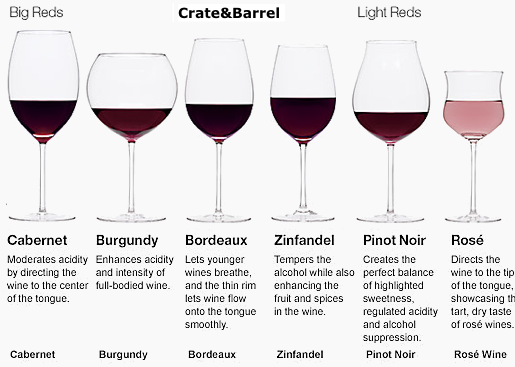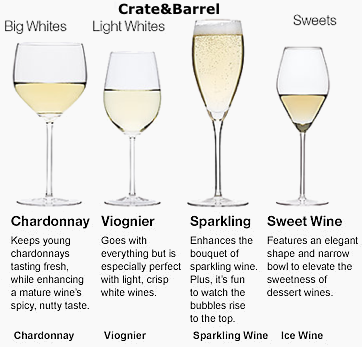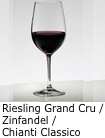 Food-Drinks
Food-Drinks
 Drinks
Drinks
 Wine
Wine
 Glasses
Glasses
Don's Home
 Food-Drinks
Food-Drinks
 Drinks
Drinks
 Wine
Wine
 Glasses
Glasses
|
| Other Pages: About Wine | Storage | serving temperature | Lifecycle - Aging | Affordable Wines | Glasses |
|
Under Construction
The size, shape and rim diameter of the wine glass can emphasize the wine's aroma, bouquet, tannins, taste and finish. Claus J. Riedel, of the Austrian glass company by that name, was the first to understand how the shape of a glass dramatically affects a wine's bouquet and flavor. He is thus the inventor of the functional wine glass designing its shape according to the character of the wine. Their 1961 catalogue featured glasses of different sizes and shapes.
The Wine Advocate's Robert Parker has described the difference Riedel's glasses can make as "profound". See Riedel Glassware | The Wine Company
Red wines and full flavoured white wines, such as oaked chardonnay are best served slightly oxidized (after breathing). The complex flavors of full bodiedare smoothed out after being exposed to air.
A wider glass helps in this oxididation.
Many sources will claim that directing wine to different parts of the tongue will affect the taste. Open glass shapes require us to sip by lowering the head, whereas a narrow rim forces the head to tilt backwards so that the liquid flows. This delivers and positions the beverage to different 'taste zones' of the palate.
The effect of glass shape on the taste of wine has not been demonstrated by any scientific study and remains controversial. It is however believed by some that the shape of the glass is important, as it concentrates the flavour and aroma (or bouquet).
Red and Rosé  Glasses for red wine are characterized by their rounder, wider bowl, which increases the rate of oxidation. As oxygen from the air chemically interacts with the wine, flavor and aroma are subtly altered. This process of oxidation is generally more compatible with red wines, whose complex flavors are smoothed out after being exposed to air.
Glasses for red wine are characterized by their rounder, wider bowl, which increases the rate of oxidation. As oxygen from the air chemically interacts with the wine, flavor and aroma are subtly altered. This process of oxidation is generally more compatible with red wines, whose complex flavors are smoothed out after being exposed to air.Click on images to go to the source. | |
|
Bordeaux glasses: Tall with a broad bowl, and is designed for full bodied red wines. This shape of bowl concentrates the aromas and flavors more than a wider-bowled glass. The narrower rim directs wine to the back of the mouth. They are good for red wine in the Cabernet/Merlot family (all the varieties of Bordeaux, for example; Sangiovese-based wines, Zinfandel, Syrah/Shiraz, Tempranillo/Rioja, Gamay/Beaujolais, Grenache, Dolcetto, Aglianico, Primitivo) |
 
|
| Burgundy glass:
Broader than the Bordeaux glass, it has a bigger bowl to accumulate aromas of more delicate red wines such as Pinot Noir/Burgundy, Barolo/Barbaresco, and Barbera. This style of glass directs wine to the tip of the tongue. | 

|
|
See Wine Review Online - The Incredible Importance of the Wine Glass | |
|
White 

White wine glasses vary enormously in size and shape, from the delicately tapered Champagne flute, to the wide and shallow glasses used to drink Chardonnay.
| |
|
Chardonnay/White Burgundy/Chablis work best in wider-bowled glasses similar to the Burgundy glass, though in such cases the bowl can be somewhat smaller.
Sauvignon Blanc, Riesling, Pinot Gris/Pinot Grigio, Albariño, Chenin Blanc, Gewörztraminer, Grüner Veltliner, Pinot Blanc/Pinot Bianco, Semillon (in other words, most white wines) usually taste better in a fairly large, elongated, somewhat narrower bowl similar to the red Bordeaux glass, but the bowl can be a bit smaller. | 
|
 All purpose glass:
All purpose glass:If you can only afford one type, Riedel recommends the Ouverture Magnum ($12) or the Vinum Riesling Grand Cru/Chianti Classico ($35).  I'd recommend the Riedel "O" cabernet/merlot or Riedel 'O' Riesling/Sauvignon Blanc ($12) stemless glasses also.
I'd recommend the Riedel "O" cabernet/merlot or Riedel 'O' Riesling/Sauvignon Blanc ($12) stemless glasses also.
|

|
|
Serving: Never over-pour. You need room to swirl the wine and lift the aromas. Maximum of 3-5 oz/glass. That's about 2 fingers. A typical glass is 15 - 24 oz, so it will not look very full. You should get 6 servings per bottle. See temperature at the wine page and Video Gallery - Riedel Type of glass: High quality wine glasses are often made of lead crystal. Lead crystal is rougher than glass on a microscopic level, allowing wine in the glass to breathe more efficiently when swirled in the bowl. The lead oxide in glass is totally integrated into the molecular structure with no leaching possible. The brilliance of lead crystal relies on the high refractive index caused by the lead content. Others:  Roberts Taste Enhancing Wineware claims that their Supertaster wine glasses have Taste Stimulating Textures™ (TST™) on the outer glass near the rim which provoke the neural receptors on the tongue, encourage saliva flow and alerts our bodies to register pleasurable sensations associated with taste and flavor recognition.
Roberts Taste Enhancing Wineware claims that their Supertaster wine glasses have Taste Stimulating Textures™ (TST™) on the outer glass near the rim which provoke the neural receptors on the tongue, encourage saliva flow and alerts our bodies to register pleasurable sensations associated with taste and flavor recognition.Is this marketing hype gone wild?
Decanting: The practice of pouring wine from the bottle into another container before serving, was used to separate sediment.
Care:
Terms:
Companies:
Riedel - Austria
Spiegelau (Owned by Riedel) - Germany
Better: Libbey - Toledo, Ohio Schott Zwiesel (a brand of Zwiesel Kristallglas, AG) - Germany Wine glasses are $7-$11 at Crate & Barrel My Favorite Wine Glasses: Best Value for the Money | The Kitchn
Links:
| |